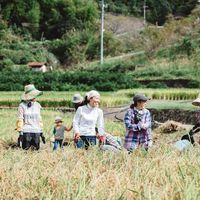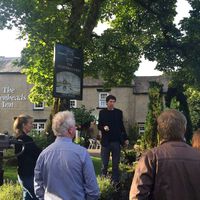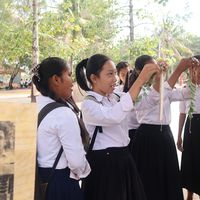#peripheries: Turning Tides: cultural strategy at a distance | United Kingdom

culture360.ASEF.org is featuring a series of articles on the topic of #peripheries. The #peripheries have been regarded as being in the geographical margin, distant from the capital cities and cultural centres of countries. With an ongoing decentralisation trend, through this series of articles, we will look at various arts endeavours by artists, cultural professionals and art organisations who operate or occupy the peripheries in an urban society and the role that the arts play. In this article, Andrew Ormston looks at several cultural policy and technological initiatives in Scotland, a country that includes some of the highest urban population densities and most dispersed rural populations in Europe, exploring how local cross-sectoral partnerships can be effective in rural and remote communities.
The portrait is of Archie Dagg, a member of my family tree, and a renowned maker and player of the Northumbrian pipes. I have two abiding memories of him. The first as a small child marvelling at the salmon in the river shallows on his remote sheep farm in North Northumberland, the second, thirty years later, recognising his handiwork, a shepherds crook, in a First Nations festival display. Archie is one reason why the peripheries are important to me.

Portrait of Archie Dagg: shepherd and traditional fiddler, piper and composer from central Northumberland
Richard Florida’s creative city mantra was ubiquitous throughout much of my career. The unspoken assumption is that aspiring creatives will move to where the action is, and the action is urban. Success was achieving critical mass through attracting creative people from other places. But what about the other places?
Peripheries are, of course, not defined by their location, but by the location of the place to which they are peripheral. In the case of the arts and creative industries, they are also defined by the cultures of those places. I say ‘cultures' because we are talking about the culture of both formal and informal institutions as well as cultural practices and narratives.
Many cultural managers and strategists of my generation have spent much of their careers attempting to rebalance urban centrism. My own work as a manager and as a consultant has involved initiatives in some of the UK’s most remote areas, from the North Pennines to Scotlands Highlands & Islands.
Work was as much fuelled by a desire to compete with established urban cultural hubs as by equitable policy considerations, partially because of a feeling that rebalancing alone was no more than a sticking plaster on a cultural system that structurally neglects peripheries. In my own case, the international recognition of Berwick Film & Media Arts Festival for its cutting edge work is an annual demonstration of what is possible in very rural settings.
In Scotland, there has been a push to understand and map cultural activity, often revealing rural activity that had been invisible to strategists. I was involved in studies into film exhibition and literature and publishing that revealed each sub-sector had over 50 thriving festivals in locations right around the country, many in rural and even remote locations.
For example, the Sensing Place project worked with documentary film and participative arts in rural areas. We found activity that no-one outside the immediate area knew about, and, in one instance, the local cultural diary even had no room for us.
New models have emerged to connect a healthy local cultural scene with nationally funded and centrally located arts infrastructure. In Shetland, I worked with Mareel, a new arts centre serving a population of 23,000 living on 16 islands, and a controversial development at a time when money to sustain other community initiatives was tight.
However, in my mind an interview with a young local woman was compelling. She had returned from university on the mainland to a creative job at home and felt lucky when so many of her creative peers were forced to relocate. The Stove Network in Dumfries is a driving force for regeneration in a rural town that was in decline. In this case, an arts project cheerfully adopted the strategies and disciplines of community development and the impact is wide ranging.
What is clear is that working in very rural and remote areas requires more flexibility to respond to local circumstances. Highlands & Islands Enterprise is an unusual example of an enterprise agency in that it integrates economic and community development. This approach extends to arts and culture. Remote communities are particularly dependent on cross sectoral relationships. The person or building selling groceries might also be running a community wind project, a community arts centre or a local festival.
The impact of technological change has been even more dramatic and has brought remote areas of the world into our lives. Nunatak, the British Antarctic Survey scientist’s rock band became an online phenomenon leading to offers of a music deal, and many millions watched videos of astronaut Chris Hadfield’s cover of Major Tom from the international space station. But in our societies everyday reality is that while communications technology enables, the market doesn’t.

Nunatak, the British Antarctic Survey scientist’s rock band
Streamed opera is a one-way transaction, from Paris to your local cinema or laptop. Remote communities may still have limited access to this beamed in culture. When working in Lewis & Harris on plans for a visitor centre for the extremely remote island of St Kilda, the locally developed 3G network was shown with as much pride as the famous Calanais standing stones. Examples of island culture streaming to events in major cities are rare and running against the tide.
Perhaps more importantly, the Scottish Government is pursuing a policy framework of community empowerment and reform, ranging from community asset transfer to land reform. These developments are as important to urban as rural communities but take up in remote areas suffering from depopulation and concentrated property ownership is notable.
However, as yet, culture has not had a strong presence in this agenda. A skeptical friend recently concluded that real community empowerment was in the film, Wicker Man, where local people ceremoniously burn visiting officials. But I don’t agree. The accumulated impact of increased digital connectedness has been centralisation and the abandonment of local offices and organisational outposts. But much of culture in digital form is only a facsimile of the real thing.
Recent, but unpublished research on creative networks in Scotland clearly showed that creative people in rural and remote areas organise themselves to support their work and the cultural life of the area. However, how they work and organise is not readily compatible with national institutions and agencies. This is often small-scale work, on a ‘shoestring’, and resistant to jumping through the bureaucratic hoops of arts funding. It is time that our national cultural bodies recognised that local cross sectoral partnerships are the only way they can be effective in rural and remote communities.
This article is written by Andrew Ormston, an international expert and consultant in cultural policy and strategy. Clients range from the Scottish Parliament to international trusts and foundations. He also works as an expert for the European Commission and is an Evaluation Strategy Adviser for the British Council. He is on the faculty of Queen Margaret University, teaching on the post-graduate cultural management programme, and is an Honorary Fellow of Edinburgh University. Andrew is a Board member of the Queen’s Hall Concert Hall, Berwick Film & Media Arts Festival and SURF (Scotland’s Regeneration Forum).






